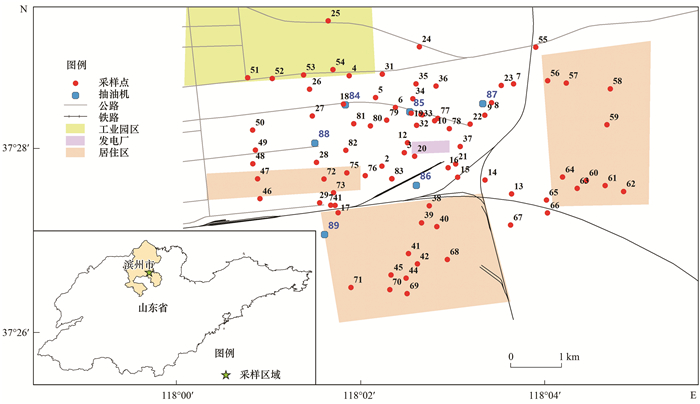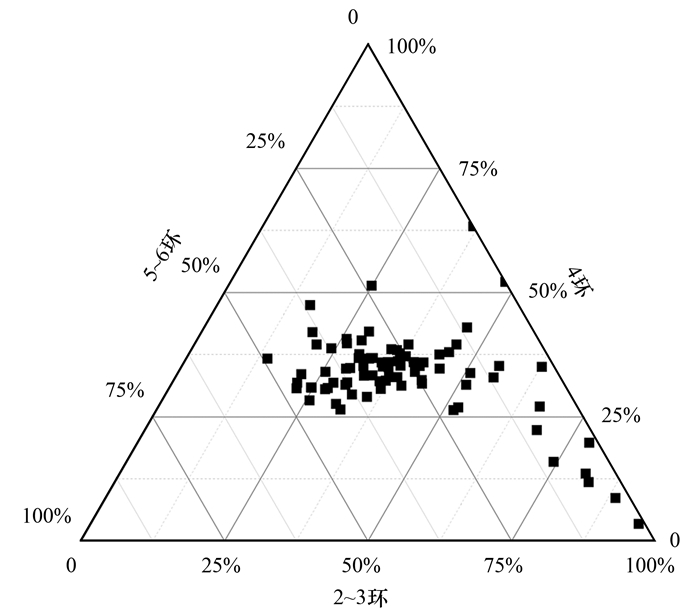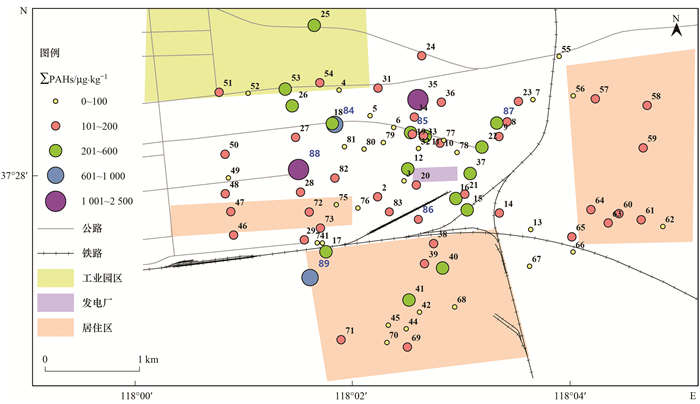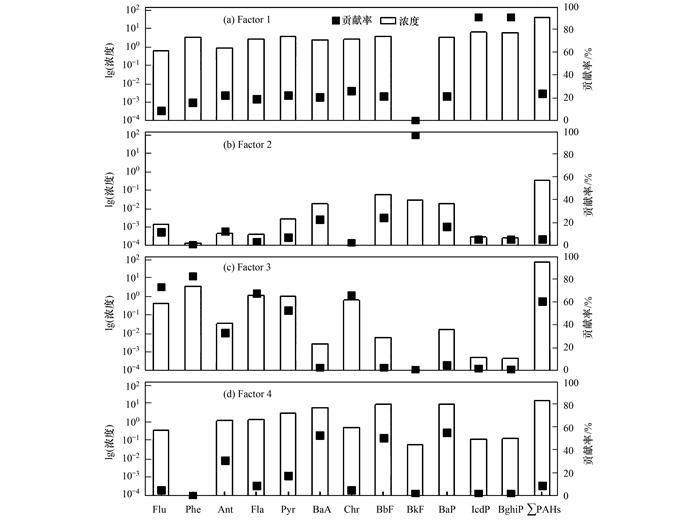2. 中国矿业大学化学与环境工程学院, 北京 100083;
3. 农业部环境保护科研监测所, 天津 300191
2. School of Chemical and Environmental Engineering, China University of Mining and Technology, Beijing 100083, China;
3. Agro-Environmental Protection Institute, Ministry of Agriculture, Tianjin 300191, China
多环芳烃(polycyclic aromatic hydrocarbons, PAHs)是环境中普遍存在的持久性有机污染物[1], 其土壤污染状况受到广泛的关注.人类活动产生的PAHs通过污水灌溉和干湿沉降等途径进入农田土壤, 进入土壤中的PAHs可通过皮肤和口腔直接进入人体, 也可被植物和动物吸收, 通过食物链危及人类健康.
近年来我国关于农田土壤PAHs的研究报道, 主要集中在东北污灌区、京津冀地区、长江三角洲地区和珠江三角洲等地区, 如刘江生[2]研究了东北某灌溉区农田土壤中16种多环芳烃, 其土壤PAHs含量为7.88~2 231.42 μg·kg-1. Peng等[3]测定北京地区16种多环芳烃, 其含量范围为93~13 141 μg·kg-1, 平均值为1 228 μg·kg-1.朱媛媛等[4]得出天津市土壤中16种PAHs的含量范围为142~1 490 μg·kg-1, 平均含量765 μg·kg-1.李静雅等[5]研究了长江三角地区11个地级市土壤中29种PAHs, 其含量范围为21.0~3 578.5 μg·kg-1, 平均值为310.6 μg·kg-1, 其中以苏州土壤中PAHs的污染最为严重.杨国义等[6]测定珠江三角洲研究区5个地级市农田土壤中16种PAHs含量为3.3~4 079.0 μg·kg-1, 平均含量244.2 μg·kg-1, 以3环和4环的PAHs为主.
黄河三角洲的盐渍化土地面积占土地总面积的63%, 其中含盐量高于0.8%的重度盐渍化土地约占1/4[7, 8].该地区石油资源丰富, 在石油开采、运输和加工过程中, 不可避免造成盐渍化土壤石油污染.依据采油井污染范围约在1 000~2 000 m2估计, 该地区石油污染盐渍化土壤面积在2 000 hm2以上.石油组分成分复杂, 主要有烷烃、芳香烃及含氮、硫化合物等, 其中PAHs作为石油的主要成分之一, 主要来自化石燃料的不完全燃烧, 具有强烈的“三致”效应.表层土壤是PAHs重要的承载体. PAHs通过大气沉降、地表径流等途径进入到农田土壤, 会被土壤中的有机质吸附[9], 很难降解, 从而造成土壤污染, 致使土壤性质发生变化, 导致本已脆弱的盐渍化土壤生态系统受到破坏, 盐渍化农田土壤石油污染问题成为当前正在面临的重要生态环境问题之一.
对环境污染物进行源解析有助于了解其主要污染途径, 进而为污染控制提供依据.源解析方法有定性方法和定量方法两大类, 定性方法就是利用污染物的化学性质进行源识别, 如比值法、特征污染物法、轮廓图法和碳同位素法[10~13]; 定量方法则是利用数学分析模型对污染物来源进行量化解析.有研究针对石油开采区有机污染场地周边农田土壤采用主成分分析方法和比值法单独进行源解析[14, 15], 但在因果关系判定方面存在源贡献率不清的问题.在定量方法中, 受体模型是一种有效的源解析工具[16~20], 其中正定矩阵因子法对源谱信息的依赖性较低, 近年来被广泛用于各种环境介质中污染物的源解析, 如边璐等[21]对降雨地表径流中的多环芳烃进行来源解析, 刘现明等[22]对大连湾沉积物中的多环芳烃进行来源解析, 王成龙[23]对长江流域水体中的多环芳烃来源解析.
本文以黄河三角洲石油开采区盐渍化农田为研究对象, 分析农田土壤样品中PAHs的污染水平和空间分布, 运用主成分分析方法与正定矩阵因子法对PAHs的来源进行探讨, 明确污染物与受体的因果关系, 以期为司法定责、生态补偿和环境管理提供理论与实践指导, 并为保护当地农田土壤环境提供科学依据.
1 材料与方法 1.1 研究区概况黄河三角洲位于中国东部, 是典型的石化工业区域.采样研究区域为山东省滨州市滨城区石油开采区周边农田(118°0′E~118°6′E, 37°26′N~37°30′N).该区域工业园区占地48 km2, 住宅生活区面积6.23 km2.全年主导风向是东南风, 频率为8%~10%.农田分布在生活区和工业区周边, 主要种植农作物是玉米、小麦、棉花等, 周边有石油开采、农药生产、炼焦工业、石油化工、燃煤发电等工业活动.高速公路、铁路等组成的交通运输网路作为链接通道, 将原材料运入以及加工产品的运出.
1.2 样品采集农田土壤采样布点主要考虑农田周边潜在污染源的分布、土地利用状况以及区域间样点分布均匀性等特点.采样区域位于工业区的东南方向, 根据抽油机以及区域道路分布, 在发电厂周围半径5km范围内, 共采集土壤样品89个, 其中6个为抽油机附近土壤样品, 其余为农田土壤样品(见图 1), 采样时用GPS记录每个采样点的经纬度, 详细记载样点的地理位置和现有及潜在污染源等信息.土壤样品为表层土壤(0~20 cm), 采用梅花采样法.采集好的样品装入自封袋中, 带回实验室-20℃冷冻保存直至分析.

|
图 1 采样点位示意 Fig. 1 Map of the sampling sites in the oil exploitation area |
土壤样品进行冷冻干燥, 去除植物根系、石子等杂质后, 过1 mm筛.
土壤样品多环芳烃预处理参见文献[24, 25]:取10 g土样, 使用加速溶剂萃取仪(瑞士步琦E-916)进行萃取, 萃取剂选择二氯甲烷和正己烷(1:1, 体积比), 萃取条件为:载气(氮气)压力:0.8 MPa; 加热温度:100℃; 萃取池压力:1×104 kPa; 预加热平衡:5 min; 静态萃取时间:5 min; 溶剂淋洗时间:4 min; 氮气吹扫时间:3 min; 静态萃取次数:2次.
将接收瓶中的提取液转移到旋转蒸发瓶中, 用适量的正己烷-二氯甲烷(1:1, 体积比)润洗接收瓶3次并转移到旋转蒸发瓶中, 旋转蒸发至2 mL.用4 mL二氯甲烷淋洗佛罗里硅土小柱, 加入5 mL正己烷待柱充满后关闭流速阀浸润5 min.继续加5 mL正己烷, 缓慢打开控制阀, 在填料暴露空气前关闭.
将提取液转移至小柱内, 用3 mL正己烷分3次洗涤旋转蒸发瓶, 并全部转移至小柱中.缓慢打开控制阀, 在填料暴露空气前关闭, 加入5 mL二氯甲烷-正己烷混合液(1:9, 体积比), 缓慢打开控制阀待洗脱液浸满柱子后关闭, 浸润2 min, 缓慢打开控制阀, 继续加5 mL二氯甲烷-正己烷洗脱液, 并收集全部.将提取液氮吹至1 mL, 转移至2 mL样品瓶中.
1.4 样品测试分析预处理完的样品用气质联用仪(岛津TQ8040)进行分析, 测定16种多环芳烃:萘(Nap)、苊烯(Acy)、苊(Ace)、芴(Flu)、菲(Phe)、蒽(Ant)、荧蒽(Fla)、芘(Pyr)、苯并[a]蒽(BaA)、
样品中的有机质使用重铬酸钾稀释热比色法测定[26]:称取过100目筛的土壤0.5 g于烧杯中, 加入3.0 mL的水, 摇匀后加入10.0 mL 0.8 mol·L-1重铬酸钾标液, 再加入10.0 mL浓硫酸, 充分摇匀后静置20 min, 再加入10.0mL水, 摇匀后静置过夜, 吸取10.0 mL于50.0 mL比色管中定容, 待测.
称取葡萄糖1.375 g, 溶于水后定容至100.0 mL, 以此制备有机碳标准溶液.吸取有机碳标准溶液0、0.5、1.0、1.5、2.0、2.5和3.0 mL, 分别补加水至3.0 mL, 之后与制备样品步骤相同.最终, 将样品与标液在590 nm波长下进行比色, 得到相应吸光度.
1.5 质量控制土壤样品多环芳烃质量控制(QA/QC)参见文献[27].使用外标法测定样品中的16种多环芳烃.每12个样品做一次全程序空白样品、加标回收样品以及平行样品, 以此来进行质量保证和质量控制.以p-Terphenyl-d14作指示剂, 得到的加标回收率为90.9%~115.9%.
1.6 数据分析方法用SPSS 24.0软件进行主成分分析和相关性分析, 用EPA PMF 5.0模型进行正定矩阵因子分析.作图软件使用ArcGIS 10.6.
2 结果与讨论 2.1 石油开采区农田土壤中多环芳烃总含量特征表 1显示的石油开采区农田土壤16种优控多环芳烃单体含量和总含量, 83个样品中, 只有Nap、Phe、Ant、Fla、Pyr和Chr的检出率为100%. 16种多环芳烃总含量(∑PAHs, 以干重计, 下同)范围为31.5~1 399.4 μg·kg-1, 平均含量为149.8 μg·kg-1.根据Trapido[28]对未受人类活动干扰的农业土壤PAHs本底值(100 μg·kg-1)的界定, 研究区域65.1%的采样点受到污染.其中, 在滨州89个土样中, ∑PAHs含量最大值是最小值的72倍, 最高值为2 287.6 μg·kg-1, 该采样点位于88号石油开采点(见图 1); 此外, ∑PAHs高于1 000的点位共有2个, 分别位于88号石油开采点和35号农田土壤采集点.
|
|
表 1 石油开采区农田土壤多环芳烃含量1)/μg·kg-1 Table 1 Concentrations of 16 PAHs in agricultural soils/μg·kg-1 |
与国内其他地区农田土壤中已报道的PAHs含量相比(表 2), 滨州石油开采区农田土壤中∑PAHs含量偏低, 略高于江苏南京长江流域稻田土壤[30], 低于其余地区农田土壤多环芳烃的含量.
|
|
表 2 其他地区农田土壤中多环芳烃的含量/μg·kg-1 Table 2 Content of PAHs in farmland soils in other areas/μg·kg-1 |
2.2 石油开采区农田土壤中多环芳烃成分组成特征
83个农田土壤样品中不同单体多环芳烃含量中, Nap平均含量最高, 为(23.6±35.5)μg·kg-1, Phe和Pyr次之, 分别为(20.6±15.3)μg·kg-1和(15.6±23.2)μg·kg-1.含量最低的是Ace, 为(0.2±1.1)μg·kg-1.单体多环芳烃的中值含量均低于它们的平均值, 这表明大多数单体多环芳烃在较低含量范围. 图 2显示的是农田土壤中多环芳烃的结构特征, 可以看出, 该区域农田土壤中2~3环多环芳烃比例较高, 所占比例为14.2%~95.5%, 平均比例为39.2%; 4环所占比例为3.4%~63.3%, 平均为33.6%; 5~6环所占比例为0%~49.2%, 平均占27.2%.其中, 低分子质量LMW PAHs(2~3环)的含量为55.4μg·kg-1, 高分子质量HMW PAHs(4~6环)的含量为94.4μg·kg-1. LMW/HMW PAHs的比值是0.587, 表明该区域HMW PAHs为农田土壤主要污染成分.这与山西某污灌区农田土壤中的多环芳烃的组成相似[35].

|
图 2 研究区农田土壤中多环芳烃结构组成 Fig. 2 Structural composition of PAHs in farmland soils of the study area |
运用ArcGIS 10.6软件统计分析模块, 将滨州89个采样点的∑PAHs含量数据进行分析(图 3), 发现含量相对较高的点位主要分布在发电厂、石油开采区以及铁路交通周边. ∑PAHs含量范围200~600μg·kg-1的采样点大多分布在发电厂周边, 距离发电厂800~1 500 m, 而采样点25和53则分布在工业园区内, 采样点18和36距离工业园区1 000 m范围内; 采样点84、88和89都是石油开采点抽油机的位置, 其∑PAHs含量范围在600~2 500 μg·kg-1.采样点88与68分别是多环芳烃含量最高和最低的点.采样点88的样品是石油开采区的土壤样品, 采样点68是在居民区周边农田采集的土壤样品.说明该区域的工业活动已经影响到周边的农田土壤.

|
图 3 研究区域农田土壤中多环芳烃含量分布 Fig. 3 Spatial distribution of total PAHs in the surface soils of the study area |
表 3显示的是各单体多环芳烃的相关性, 各单体多环芳烃组分之间大多存在显著相关性(P < 0.05或P < 0.01), 除Nap和BkF以外, 表明研究区域内多环芳烃的来源具有一定的相似性, 与其他研究所得到的结果相似[36, 37].
|
|
表 3 多环芳烃与土壤有机质的相关性1) Table 3 Correlations between PAHs and soil organic matter |
如表 3所示, 多环芳烃总含量与有机质的相关性较弱, 并没有明显的相关性.与其他研究区域相比较, Wang[38]也得出了相似的结果.张迪瀚等[39]的研究认为在污染程度较弱的土壤中, 多环芳烃与有机质的含量之间不存在明显相关性, 只有当PAHs的污染到达一定含量水平, PAHs与有机质含量的相关性才会凸显.
2.5 土壤中多环芳烃来源分析 2.5.1 主成分分析法(PCA)主成分分析法是一种多元统计方法.运用主成分分析法定量解析农用地土壤中多环芳烃的来源, 以特征值大于1的成分作为主成分, 通过方差极大法对因子进行旋转, 经正交旋转后的因子载荷, 当单体PAH的因子载荷在0.5以下则被剔除, 若单体PAH的因子载荷在0.5以上且解释方差累计比例大于50%, 则认为达到要求.由表 4可知, 两个因子可以解释87.7%的方差.
|
|
表 4 方差旋转所得因子分析得分1) Table 4 Factor analysis scores following Varimax rotation for each PAH |
因子1解释了79.6%的方差, 由3~6环多环芳烃组成, 包括Acy、Ace、Flu、Phe、Ant、Fla、Pyr、BaA、Chr、BbF、BaP、IcdP、DahA和BghiP. LMW PAHs与HMW PAHs均存在这个因子中, 这表明该因子是一个混合源.一些研究者发现LMW PAHs是煤或生物质燃烧的标志物, 尤其在家用燃烧和炼焦过程中的低温煤燃烧过程[40, 41]. HMW PAHs主要来源于交通相关排放[25, 42~44].综上, 因子1反映研究区农田土壤中多环芳烃的来源为煤、生物质以及化石燃料的燃烧.
因子2解释了8.1%的方差, 主要是BkF. BkF主要是柴油的燃烧[45, 46].这可能是受到拖拉机等农用器械的影响(燃油尾气排放以及燃油渗漏).因此, 因子2反映了交通排放.
2.5.2 正定矩阵因子法(PMF)该模型通过信噪比检查, 判断单体多环芳烃的数据质量.信噪比大于1的表明该物质是强信号, 小于0.5的表明是差信号, 在0.5~1之间表明是弱信号.与此同时, 如果含量实际值与预测值具有较差的匹配性, 那么该物质也要被划分为差信号.因此, 在本研究中得到:强信号(Flu、Phe、Ant、Fla、BaA、BbF、BkF、BaP、IcdP和BghiP)、弱信号(Pyr和Chr)以及差信号(Nap、Acy、Ace和DahA). PMF模型的因子数由Q(稳健)与Q(真)来决定.本研究结果得出4个因子数是最为合适的.
PMF的运行结果见图 4.因子1主要由IcdP和BghiP组成, 占总来源的24.05%, 它们是汽油[47~49]以及重油燃烧的典型产物[50, 51].滨州工业园区交通便利, 有高速公路、铁路组成的交通枢纽, 周边为公路运输枢纽, 交通尾气的排放, 即汽油的燃烧可产生IcdP和BghiP.因此, 因子1代表了交通排放源.

|
图 4 PMF模型得到的PAHs因子成分 Fig. 4 Factor profiles for PAHs sources in farmland soils obtained using PMF |
因子2的主要物质是BkF, 占总来源的6.17%. BkF是柴油燃烧的产物.这可能与当地收割机、拖拉机等农用机械的使用有关, 其大多以柴油机为动力.因此, 因子2代表了交通排放源.
因子3的来源贡献率是60.67%, 主要物质是Phe、Flu、Fla、Chr和Pyr.这些属于3~4环的多环芳烃, 表明木材以及生物质的燃烧是主要的来源[52].研究区域的村民生活存在生物质燃烧现象(如烹饪方式、秸秆燃烧). Flu和Phe也是炼焦产物[53], 且Flu、Pyr以及Phe通常是煤燃烧的标志物[54].一些研究表明LMW PAHs是低温热解过程中的重要燃烧产物[55].因此, 这个来源是低温热解过程, 包括煤和生物质的燃烧.
因子4主要由BaP、BbF和BaA组成, 其贡献率是9.11%.这些物质通常是煤燃烧的产物.这可能与当地的工业活动相关:发电厂以及工厂锅炉大多以燃煤获得生产动力, 该研究区域存在农药生产、炼焦工业、石油化工、燃煤发电等工业活动.因此, 因子4代表煤的燃烧.
2.5.3 两种源解析方法的比较传统的基于多环芳烃组分含量比的源解析方法一般只可以对污染源进行定性.为了更好地解析多环芳烃的来源, 有必要使用定量方法.本研究采用了主成分分析和正定矩阵因子模型进行多环芳烃来源的定量分析.
主成分分析法和正定矩阵因子法都可以在不需要已知污染源成分的情况下, 通过样品的含量估计来源.然而, 主成分分析法不能给出各因子源贡献的定量结果.与主成分分析法相比, 正定矩阵因子法可以更好地解释来源, 可以更详尽地解释污染源.除此之外, 正定矩阵因子的输出结果是非负的.而主成分分析法的结果会出现负值.
在本研究中, PMF解析出4种源:汽油燃烧(24.05%)、柴油燃烧(6.17%)、低温热解过程(60.67%)与煤燃烧(9.11%).主成分分析法解析了煤、生物质和化石燃料燃烧的混合源以及柴油燃烧源.两种方法得出的源成分谱是相似的.
3 结论本文对山东滨州石油开采区农田土壤中优先控制的16种典型PAHs的含量进行了分析, 研究区域的多环芳烃的总含量范围是31.5~1 399.4 μg·kg-1, 平均值为149.8μg·kg-1, 中位值为119.4 μg·kg-1, LMW/HMW PAHs的比值是0.587, 表明该区域农田土壤中以高分子量多环芳烃为主.该区域各单体多环芳烃组分之间大多存在显著相关性(P < 0.05或P < 0.01), 而多环芳烃的总含量与有机质的相关性不显著.相关研究表明这或许与多环芳烃的污染含量水平相关. ∑PAHs含量较高的采样点主要分布在发电厂、抽油机石油开采区以及铁路交通周边.运用主成分分析和正定矩阵因子法模型判断了农田土壤中多环芳烃的来源, 两种源解析方法的解析结果是相似的.主成分分析的结果是以煤、生物质和化石燃料燃烧为主的混合源以及柴油燃烧源; 正定矩阵因子法的解析结果是汽油燃烧(24.05%)、柴油燃烧(6.17%)、低温热解过程(60.67%)与煤燃烧(9.11%).
| [1] | Hoffman E J, Mills G L, Latimer J S., et al. Urban runoff as a source of polycyclic aromatic hydrocarbons to coastal waters[J]. Environmental Science & Technology, 1984, 18(8): 580-587. |
| [2] | 刘江生.东北老工业基地浑蒲灌区土壤中多环芳烃污染特征、断代、溯源及风险评价研究[D].济南: 山东大学, 2009. |
| [3] | Peng C, Chen W P, Liao X L, et al. Polycyclic aromatic hydrocarbons in urban soils of Beijing:status, sources, distribution and potential risk[J]. Environmental Pollution, 2011, 159(3): 802-808. DOI:10.1016/j.envpol.2010.11.003 |
| [4] |
朱媛媛, 田靖, 魏恩琪, 等. 天津市土壤多环芳烃污染特征、源解析和生态风险评价[J]. 环境化学, 2014, 33(2): 248-255. Zhu Y Y, Tian J, Wei E Q, et al. Characteristics, sources apportionment and ecological risks assessment of polycyclic aromatic hydrocarbons in soils of Tianjin, China[J]. Environmental Chemistry, 2014, 33(2): 248-255. |
| [5] |
李静雅, 吴迪, 许芸松, 等. 长江三角洲区域表土中多环芳烃的近期分布与来源[J]. 环境科学, 2016, 37(1): 253-261. Li J Y, Wu D, Xu Y S, et al. Recent distribution and sources of polycyclic aromatic hydrocarbons in surface soils from Yangtze River Delta[J]. Environmental Science, 2016, 37(1): 253-261. |
| [6] |
杨国义, 张天彬, 高淑涛, 等. 珠江三角洲典型区域农业土壤中多环芳烃的含量分布特征及其污染来源[J]. 环境科学, 2007, 28(10): 2350-2354. Yang G Y, Zhang T B, Gao S T, et al. Source and distribution characteristics of polycyclic aromatic hydrocarbons in agricultural soils in the Pearl River Delta[J]. Environmental Science, 2007, 28(10): 2350-2354. DOI:10.3321/j.issn:0250-3301.2007.10.034 |
| [7] |
王红, 宫鹏, 刘高焕. 黄河三角洲多尺度土壤盐分的空间分异[J]. 地理研究, 2006, 25(4): 649-658. Wang H, Gong P, Liu G H. Multi-scale spatial variations in soil salt in the Yellow River Delta[J]. Geographical Research, 2006, 25(4): 649-658. DOI:10.3321/j.issn:1000-0585.2006.04.011 |
| [8] |
姚荣江, 杨劲松. 基于电磁感应仪的黄河三角洲地区土壤盐分时空变异特征[J]. 农业工程学报, 2008, 24(3): 107-113. Yao R J, Yang J S. Spatio-temporal variability of soil salinity in the Yellow River Delta using electromagnetic induction[J]. Transactions of the CSAE, 2008, 24(3): 107-113. DOI:10.3321/j.issn:1002-6819.2008.03.022 |
| [9] | Means J C, Wood S G, Hassett J J, et al. Sorption of polynuclear aromatic hydrocarbons by sediments and soils[J]. Environmental Science & Technology, 1980, 14(12): 1524-1528. |
| [10] | Yunker M B, Macdonald R W, Vingarzan R, et al. PAHs in the Fraser River basin:a critical appraisal of PAH ratios as indicators of PAH source and composition[J]. Organic Geochemistry, 2002, 33(4): 489-515. DOI:10.1016/S0146-6380(02)00002-5 |
| [11] | Zhou J L, Siddiqui E, Ngo H H, et al. Estimation of uncertainty in the sampling and analysis of polychlorinated biphenyls and polycyclic aromatic hydrocarbons from contaminated soil in Brighton, UK[J]. Science of the Total Environment, 2014, 497-498: 163-171. DOI:10.1016/j.scitotenv.2014.07.097 |
| [12] | 翟梦晓.黄淮水系河南段表层沉积物中多环芳烃的赋存特征及来源解析[D].新乡: 河南师范大学, 2011. |
| [13] | Lin C, Liu J L, Wang R M, et al. Polycyclic aromatic hydrocarbons in surface soils of Kunming, China:concentrations, distribution, sources, and potential risk[J]. Soil and Sediment Contamination:An International Journal, 2013, 22(7): 753-766. DOI:10.1080/15320383.2013.768201 |
| [14] | Zuo Q, Duan Y H, Yang Y, et al. Source apportionment of polycyclic aromatic hydrocarbons in surface soil in Tianjin, China[J]. Environmental Pollution, 2007, 147(2): 303-310. DOI:10.1016/j.envpol.2006.05.029 |
| [15] | Macaskill N D, Walker T R, Oakes K, et al. Forensic assessment of polycyclic aromatic hydrocarbons at the former Sydney Tar Ponds and surrounding environment using fingerprint techniques[J]. Environmental Pollution, 2016, 212: 166-177. DOI:10.1016/j.envpol.2016.01.060 |
| [16] |
薛荔栋, 郎印海, 刘爱霞, 等. 黄海近岸表层沉积物中多环芳烃来源解析[J]. 生态环境, 2008, 17(4): 1369-1375. Xue L D, Lang Y H, Liu A X, et al. Source apportionment of polycyclic aromatic hydrocarbons in coastal surface sediments from the Yellow Sea[J]. Ecology and Environment, 2008, 17(4): 1369-1375. DOI:10.3969/j.issn.1674-5906.2008.04.009 |
| [17] | Jiang Y F, Wang X T, Wang F, et al. Levels, composition profiles and sources of polycyclic aromatic hydrocarbons in urban soil of Shanghai, China[J]. Chemosphere, 2009, 75(8): 1112-1118. DOI:10.1016/j.chemosphere.2009.01.027 |
| [18] |
罗孝俊, 陈社军, 麦碧娴, 等. 珠江三角洲地区水体表层沉积物中多环芳烃的来源、迁移及生态风险评价[J]. 生态毒理学报, 2006, 1(1): 17-24. Luo X J, Chen S J, Mai B X, et al. Source, transport and risk assessment of PAHs in surface sediments from Pearl River Delta[J]. Asian Journal of Ecotoxicology, 2006, 1(1): 17-24. |
| [19] | Warren C S, Mackay D, Bahadur N P, et al. A suite of multi-segment fugacity models describing the fate of organic contaminants in aquatic systems:application to the Rihand Reservoir, India[J]. Water Research, 2002, 36(17): 4341-4355. DOI:10.1016/S0043-1354(02)00161-6 |
| [20] | Shi G L, Liu G R, Peng X, et al. A comparison of multiple combined models for source apportionment, including the PCA/MLR-CMB, Unmix-CMB and PMF-CMB models[J]. Aerosol and Air Quality Research, 2014, 14(7): 2040-2050. DOI:10.4209/aaqr.2014.01.0024 |
| [21] |
边璐, 李田, 侯娟. PMF和PCA/MLR法解析上海市高架道路地表径流中多环芳烃的来源[J]. 环境科学, 2013, 34(10): 3840-3846. Bian L, Li T, Hou J. Source apportionment of polycyclic aromatic hydrocarbons using two mathematical models for runoff of the Shanghai elevated inner highway, China[J]. Environmental Science, 2013, 34(10): 3840-3846. |
| [22] |
刘现明, 徐学仁, 张笑天, 等. 大连湾沉积物中PAHs的初步研究[J]. 环境科学学报, 2001, 21(4): 507-509. Liu X M, Xu X R, Zhang X T, et al. A preliminary study on PAHs in the surface sediment samples from Dalian Bay[J]. Acta Scientiae Circumstantiae, 2001, 21(4): 507-509. DOI:10.3321/j.issn:0253-2468.2001.04.026 |
| [23] |
王成龙, 邹欣庆, 赵一飞, 等. 基于PMF模型的长江流域水体中多环芳烃来源解析及生态风险评价[J]. 环境科学, 2016, 37(10): 3789-3797. Wang C L, Zou X Q, Zhao Y F, et al. Source apportionment and ecological risk assessment of polycyclic aromatic hydrocarbons in surface water from Yangtze River, China:based on PMF Model[J]. Environmental Science, 2016, 37(10): 3789-3797. |
| [24] |
吕金刚, 毕春娟, 陈振楼, 等. 上海市崇明岛农田土壤中多环芳烃分布和生态风险评价[J]. 环境科学, 2012, 33(12): 4270-4275. Lü J G, Bi C J, Chen Z L, et al. Distribution and ecological risk assessment of polycyclic aromatic hydrocarbons in agricultural soil of the Chongming Island in Shanghai[J]. Environmental Science, 2012, 33(12): 4270-4275. |
| [25] | Syed J H, Iqbal M, Zhong G C, et al. Polycyclic aromatic hydrocarbons (PAHs) in Chinese forest soils:profile composition, spatial variations and source apportionment[J]. Scientific Reports, 2017, 7(1): 2692. DOI:10.1038/s41598-017-02999-0 |
| [26] |
谢细香. 重铬酸钾稀释热比色法测定土壤有机质的研究[J]. 安徽农业科学, 2005, 33(6): 998-999. Xie X X. Determination of organic matter in soil with the method of potassium bichromate-dilution heat colorimetric[J]. Journal of Anhui Agricultural Sciences, 2005, 33(6): 998-999. DOI:10.3969/j.issn.0517-6611.2005.06.036 |
| [27] | Wang C H, Wu S H, Zhou S L, et al. Polycyclic aromatic hydrocarbons in soils from urban to rural areas in Nanjing:concentration, source, spatial distribution, and potential human health risk[J]. Science of the Total Environment, 2015, 527-528: 375-383. DOI:10.1016/j.scitotenv.2015.05.025 |
| [28] | Trapido M. Polycyclic aromatic hydrocarbons in Estonian soil:contamination and profiles[J]. Environmental Pollution, 1999, 105(1): 67-74. DOI:10.1016/S0269-7491(98)00207-3 |
| [29] |
周玲莉, 薛南冬, 李发生, 等. 黄淮平原农田土壤中多环芳烃的分布、风险及来源[J]. 中国环境科学, 2012, 32(7): 1250-1256. Zhou L L, Xue N D, Li F S, et al. Distribution, source analysis and risk assessment of polycyclic aromatic hydrocarbons in farmland soils in Huanghuai Plain[J]. China Environmental Science, 2012, 32(7): 1250-1256. DOI:10.3969/j.issn.1000-6923.2012.07.016 |
| [30] |
丁爱芳, 潘根兴, 李恋卿. 江苏省部分地区农田表土多环芳烃含量比较及来源分析[J]. 生态与农村环境学报, 2007, 23(2): 71-75. Ding A F, Pan G X, Li L Q. Contents and sources of PAHs in top soils of farmlands in parts of Jiangsu, China[J]. Journal of Ecology and Rural Environment, 2007, 23(2): 71-75. DOI:10.3969/j.issn.1673-4831.2007.02.015 |
| [31] |
刘增俊, 滕应, 黄标, 等. 长江三角洲典型地区农田土壤多环芳烃分布特征与源解析[J]. 土壤学报, 2010, 47(6): 1110-1117. Liu Z J, Teng Y, Huang B, et al. Distribution and sources analysis of PAHs in farmland soils in areas typical of the Yangtze River Delta, China[J]. Acta Pedologica Sinica, 2010, 47(6): 1110-1117. |
| [32] | Nam J J, Song B H, Eom K C, et al. Distribution of polycyclic aromatic hydrocarbons in agricultural soils in South Korea[J]. Chemosphere, 2003, 50(10): 1281-1289. DOI:10.1016/S0045-6535(02)00764-6 |
| [33] | Stalikas C D, Chaidou C I, Pilidis G A. Enrichment of PAHs and heavy metals in soils in the vicinity of the lignite-fired power plants of West Macedonia (Greece)[J]. Science of the Total Environment, 1997, 204(2): 135-146. DOI:10.1016/S0048-9697(97)00156-3 |
| [34] | Bayat J, Hashemi S H, Khoshbakht K, et al. Monitoring of polycyclic aromatic hydrocarbons on agricultural lands surrounding Tehran oil refinery[J]. Environmental Monitoring and Assessment, 2015, 187(7): 451. DOI:10.1007/s10661-015-4646-8 |
| [35] |
刘庚, 牛俊杰, 王玲, 等. 污灌区农田土壤多环芳烃污染及风险评价[J]. 环境化学, 2017, 36(7): 1622-1629. Liu G, Niu J J, Wang L, et al. Contamination and risk assessment of PAHs in agricultural soil from wastewater irrigated area[J]. Environmental Chemistry, 2017, 36(7): 1622-1629. |
| [36] |
吴迪, 汪宜龙, 刘伟健, 等. 河北邯郸钢铁冶炼区周边麦田土和小麦籽粒的多环芳烃含量及其组分谱特征[J]. 环境科学, 2016, 37(2): 740-749. Wu D, Wang Y L, Liu W J, et al. Concentrations and component profiles PAHs in surface soils and wheat grains from the cornfields close to the steel smelting industry in Handan, Hebei Province[J]. Environmental Science, 2016, 37(2): 740-749. |
| [37] |
王学彤, 贾英, 孙阳昭, 等. 典型污染区农业土壤中PAHs的分布、来源及生态风险[J]. 环境科学学报, 2009, 29(11): 2433-2439. Wang X T, Jia Y, Sun Y Z, et al. Distribution, sources and ecological risk assessment of polycyclic aromatic hydrocarbons in agricultural soils from a typical contaminated area[J]. Acta Scientiae Circumstantiae, 2009, 29(11): 2433-2439. |
| [38] | Wang C F, Wang X P, Gong P, et al. Polycyclic aromatic hydrocarbons in surface soil across the Tibetan Plateau:spatial distribution, source and air-soil exchange[J]. Environmental Pollution, 2014, 184: 138-144. DOI:10.1016/j.envpol.2013.08.029 |
| [39] |
张迪瀚, 马永亮, 贺克斌, 等. 北京市大气颗粒物中多环芳烃(PAHs)污染特征[J]. 环境科学, 2006, 27(7): 1269-1275. Zhang D H, Ma Y L, He K B, et al. Characteristics of polycyclic aromatic hydrocarbons (PAHs) on airborne particulates in Beijing[J]. Environmental Science, 2006, 27(7): 1269-1275. DOI:10.3321/j.issn:0250-3301.2006.07.003 |
| [40] | Ravindra K, Sokhi R, van Grieken R. Atmospheric polycyclic aromatic hydrocarbons:Source attribution, emission factors and regulation[J]. Atmospheric Environment, 2008, 42(13): 2895-2921. DOI:10.1016/j.atmosenv.2007.12.010 |
| [41] | Jenkins B M, Jones A D, Turn S Q, et al. Emission factors for polycyclic aromatic hydrocarbons from biomass burning[J]. Environmental Science & Technology, 1996, 30(8): 2462-2469. |
| [42] | Yang Y, Zhang N, Xue M, et al. Effects of soil organic matter on the development of the microbial polycyclic aromatic hydrocarbons (PAHs) degradation potentials[J]. Environmental Pollution, 2011, 159(2): 591-595. DOI:10.1016/j.envpol.2010.10.003 |
| [43] | Liu Y, Beckingham B, Ruegner H, et al. Comparison of sedimentary PAHs in the rivers of Ammer (Germany) and Liangtan (China):differences between early- and newly-industrialized countries[J]. Environmental Science & Technology, 2013, 47(2): 701-709. |
| [44] | Shen G F, Chen Y C, Wei S Y, et al. Can Coronene and/or Benzo(a)pyrene/Coronene ratio act as unique markers for vehicle emission?[J]. Environmental Pollution, 2014, 184: 650-653. DOI:10.1016/j.envpol.2013.08.020 |
| [45] | Boonyatumanond R, Wattayakorn G, Togo A, et al. Distribution and origins of polycyclic aromatic hydrocarbons (PAHs) in riverine, estuarine, and marine sediments in Thailand[J]. Marine Pollution Bulletin, 2006, 52(8): 942-956. DOI:10.1016/j.marpolbul.2005.12.015 |
| [46] | Kavouras I G, Koutrakis P, Tsapakis M, et al. Source apportionment of urban particulate aliphatic and polynuclear aromatic hydrocarbons (PAHs) using multivariate methods[J]. Environmental Science & Technology, 2001, 35(11): 2288-2294. |
| [47] | Khalili N R, Scheff P A, Holsen T M. PAH source fingerprints for coke ovens, diesel and, gasoline engines, highway tunnels, and wood combustion emissions[J]. Atmospheric Environment, 1995, 29(4): 533-542. DOI:10.1016/1352-2310(94)00275-P |
| [48] | Larsen R K, Baker J E. Source apportionment of polycyclic aromatic hydrocarbons in the urban atmosphere:a comparison of three methods[J]. Environmental Science & Technology, 2003, 37(9): 1873-1881. |
| [49] | Jo W K, Lee J H. In-vehicle levels of naphthalene and monocyclic aromatic compounds according to vehicle type[J]. Environmental Engineering Research, 2009, 14(3): 180-185. DOI:10.4491/eer.2009.14.3.180 |
| [50] | Harrison R M, Smith D J T, Luhana L. Source apportionment of atmospheric polycyclic aromatic hydrocarbons collected from an urban location in Birmingham, U. K.[J]. Environmental Science & Technology, 1996, 30(3): 825-832. |
| [51] | Lee J H, Gigliotti C L, Offenberg J H, et al. Sources of polycyclic aromatic hydrocarbons to the Hudson River Airshed[J]. Atmospheric Environment, 2004, 38(35): 5971-5981. DOI:10.1016/j.atmosenv.2004.07.004 |
| [52] | Liu D, Lin T, Syed J H, et al. Concentration, source identification, and exposure risk assessment of PM2.5-bound parent PAHs and nitro-PAHs in atmosphere from typical Chinese cities[J]. Scientific Reports, 2017, 7(1): 10398. DOI:10.1038/s41598-017-10623-4 |
| [53] | Dong T T T, Lee B K. Characteristics, toxicity, and source apportionment of polycylic aromatic hydrocarbons (PAHs) in road dust of Ulsan, Korea[J]. Chemosphere, 2009, 74(9): 1245-1253. DOI:10.1016/j.chemosphere.2008.11.035 |
| [54] | Tian F L, Chen J W, Qiao X L, et al. Sources and seasonal variation of atmospheric polycyclic aromatic hydrocarbons in Dalian, China:Factor analysis with non-negative constraints combined with local source fingerprints[J]. Atmospheric Environment, 2009, 43(17): 2747-2753. DOI:10.1016/j.atmosenv.2009.02.037 |
| [55] | Simcik M F, Eisenreich S J, Lioy P J. Source apportionment and source/sink relationships of PAHs in the coastal atmosphere of Chicago and Lake Michigan[J]. Atmospheric Environment, 1999, 33(30): 5071-5079. DOI:10.1016/S1352-2310(99)00233-2 |
 2019, Vol. 40
2019, Vol. 40


